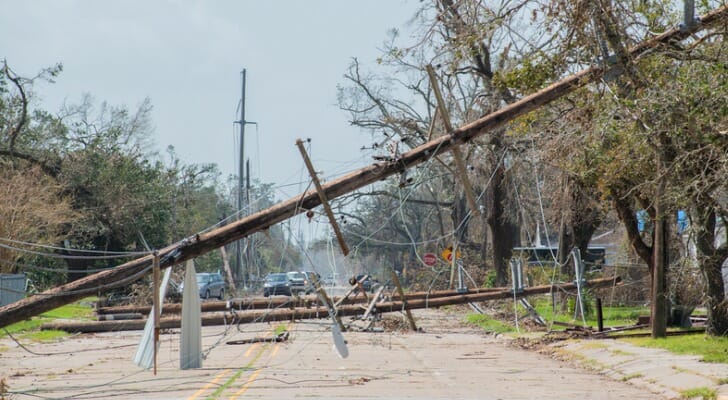 When a catastrophic event occurs, insurance and reinsurance companies step in to take care of policyholders. Major claims like this can have a significant impact on an insurer’s financials, so they look for strategies to spread the risk around. One strategy is called a catastrophy bond. Arranging for protection from unforeseen developments is best done in consultation with a financial advisor.
When a catastrophic event occurs, insurance and reinsurance companies step in to take care of policyholders. Major claims like this can have a significant impact on an insurer’s financials, so they look for strategies to spread the risk around. One strategy is called a catastrophy bond. Arranging for protection from unforeseen developments is best done in consultation with a financial advisor.
What Is a Catastrophe Bond (CAT)?
Major catastrophe events, like the Northridge, Calif., earthquake, that happened in the 1990s made insurers realize that a single event (or succession of them) could make it difficult for them to pay out all claims. Depending on the circumstances of one of these events, an insurer could fail if the claims were large enough.
Catastrophe bonds (CATs) were first introduced in the mid-1990s as a way to diversify risk for the world’s largest insurers and reinsurance companies. They are also commonly known as “insurance-linked securities.” While most issuers are insurance and reinsurance companies, some are also corporations or sovereign entities looking to hedge their risk.
CAT bonds are typically sold to capital market investors. The bonds offer an attractive interest rate in exchange for investors taking on the risks of a catastrophic loss or a named peril event. If a qualifying event occurs, then investors lose some or all of their investment, while the issuer of the bond receives the money to cover their losses.
Benefits and Risks of Catastrophe Bonds
 Here are a few of the benefits that catastrophe bonds provide benefits for investors, policyholders and insurance companies. Keep in mind that there are, in certain situations, other benefits as well. Each individual bond will offer distinctive advantages.
Here are a few of the benefits that catastrophe bonds provide benefits for investors, policyholders and insurance companies. Keep in mind that there are, in certain situations, other benefits as well. Each individual bond will offer distinctive advantages.
- Non-correlated investment. Investors look to diversify their portfolios and find assets that have a low correlation to the stock and bond markets. Because of their purpose, CAT bonds generally are not linked to economic conditions or financial markets.
- High-yielding bonds. CATs offer a competitive interest rate with other fixed-income bonds and dividend-paying stocks.
- Short duration. These bonds tend to have short maturities and, therefore, there is less likelihood of an event triggering a payout. Investors receive payments throughout the bond’s duration, so they provide a reliable income.
- Lowers insurance costs for all. Because no single insurance company is covering the risk by themselves, it lowers their out-of-pocket costs when a catastrophic event occurs. These bonds provide insurance companies with the capital to pay out claims when they need it the most. This avoids unpaid bills for policyholders filing claims and bankruptcy or a damaged reputation for the insurer.
While there are numerous benefits of catastrophe bonds, there are reasons to be cautious with them as well:
- Potential for 100% loss. When an investor buys a CAT bond, there is the potential for a complete loss of their investment if the catastrophe is large enough.
- Major catastrophe could impact financial markets. CAT bonds are seen as non-correlated assets. However, catastrophes can also happen during recessions. Some events have the potential to impact the economy significantly and possibly even trigger a recession. This scenario could result in losses to both CAT bonds and stock investments at the same time.
- Difficult to forecast when a loss would occur. Although CAT bonds are short-term in nature, catastrophic events are difficult to forecast. Catastrophic events seem to be happening at a more frequent pace, which can make historical models inaccurate at predicting losses.
The Bottom Line
 Most investors will not invest directly in a CAT bond. Instead, these investments are typically held by institutional investors, such as hedge funds and pension funds. However, CAT bonds are becoming more available to the average investor through mutual funds and ETFs that track an underlying index, such as the Swiss Re Cat Bond Performance Index. This is a more prudent approach for the typical investor. These funds tend to offer a lower minimum investment amount and provide immediate diversification. Through a fund, you’ll own many different CAT bonds and avoid a concentration risk with a single investment.
Most investors will not invest directly in a CAT bond. Instead, these investments are typically held by institutional investors, such as hedge funds and pension funds. However, CAT bonds are becoming more available to the average investor through mutual funds and ETFs that track an underlying index, such as the Swiss Re Cat Bond Performance Index. This is a more prudent approach for the typical investor. These funds tend to offer a lower minimum investment amount and provide immediate diversification. Through a fund, you’ll own many different CAT bonds and avoid a concentration risk with a single investment.
Tips on Investing
- Institutional investors use catastrophe bonds to reduce risk and generate higher returns. Investors can do the same by diversifying their portfolios and seeking out non-correlated assets. Our asset allocator tool provides guidance on how to allocate your assets to match your risk tolerance and investment timeline.
- Finding the ideal asset allocation can be a challenge for the average investor. A financial advisor’s job is to help to find the right investment mix to take advantage of tax benefits, investment options and investing strategies. Finding a qualified financial advisor doesn’t have to be hard. SmartAsset’s free tool matches you with up to three financial advisors in your area, and you can interview your advisor matches at no cost to decide which one is right for you. If you’re ready to find an advisor who can help you achieve your financial goals, get started now.
Photo credit: ©iStock.com/Leslie Scarbrough, ©iStock.com/THEGIFT777, ©iStock.com/Firmafotografen